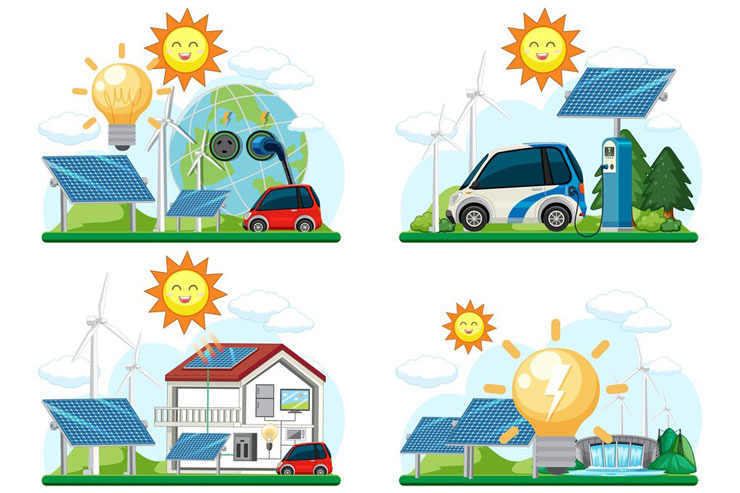Introduction
Solar power plays a role, in the realm of energy due to its cleanliness and abundant availability. With mounting worries regarding climate change and energy stability there is a rising trend in both interest and financial backing towards innovations on a global scale. This piece delves into the impacts of progress in solar energy, on our energy landscapes covering innovations, governmental regulations and economic viability. Let’s dive in!
Understanding Sun Solar Energy
What is Sun Solar Energy?
The sunlight that hits the earth can provide enough energy to power the world for a year in just 90 minutes. Solar technologies use the sun solar energy to make electricity, either with photovoltaic (PV) panels or mirrors that focus the sun’s rays. This electricity can be used immediately or stored in batteries or thermal storage for later use.
The History of Solar Energy
The development of solar energy dates back to the 7th century B.C., when sunlight was magnified to light fires. From the first photovoltaic cell in the 1950s to today’s high-efficiency panels, solar energy’s journey reflects human creativity and the quest for sustainability.
Current State of Solar Energy
Solar energy providers generate over 720 gigawatts globally, illuminating millions of homes and businesses. Countries like China, the United States, and India are at the forefront, harnessing the sun’s power to power their growth sustainably.
Innovations in Sun Solar Energy Technologies
Innovations in solar energy technologies are making harnessing the sun’s power easier and more efficient. These advancements are helping us create cleaner energy and reduce our reliance on fossil fuels. Let’s get to know more about these advancements:
Photovoltaic (PV) Systems
Photovoltaic systems convert sunlight directly into electricity using semiconductor materials that exhibit the photovoltaic effect. Breakthroughs in nanotechnology and material science have enhanced PV cell efficiency, making solar power more accessible and affordable.
Concentrated Solar Power (CSP)
Unlike PV systems, CSP uses mirrors or lenses to concentrate a large area of sunlight onto a small area to generate thermal energy. Recent developments include higher temperature systems that increase efficiency, broadening CSP’s applicability in industrial heat production.
Solar Storage Solutions
Storing solar energy is very important for managing supply and demand, ensuring stability even when the sun doesn’t shine. Innovations like lithium-ies and flow batteries offer enhanced storage capacity and stability, revolutionising how solar energy is utilised.
Smart Solar Grids
Smart grids use digital technology to monitor and manage the transport of electricity from all generation sources to meet varying electricity demands. With real-time data analysis and responsive distribution networks, smart grids optimise solar energy use, reducing waste and increasing reliability.
Sun Solar Energy Applications
Solar energy has a wide range of applications; let’s get to know a few of them in detail:
Residential Solar Solutions
Solar panels for homes convert sunlight into electricity, reducing reliance on traditional power grids and cutting energy costs. While offering energy independence and lower bills, residential solar systems require significant upfront investment and adequate sunlight to be effective.
Commercial and Industrial Solar Installations
Large-scale sun solar energy solutions power everything from factories to office buildings, significantly reducing carbon footprints. Companies like Infosys and Tata Motors in India have successfully implemented solar solutions, showcasing substantial energy cost savings and sustainability.
Solar Energy in Transportation
Innovations in solar energy include vehicles powered by photovoltaic cells, reducing reliance on fossil fuels. Buses and cars with integrated solar panels exemplify how solar energy is making strides in the transportation sector.
The Benefits of Sun Solar Energy
Now that you have understood the details let’s get to the benefits of using sun solar energy:
Environmental Benefits
- Reducing Emissions: Sun solar energy solutions are critical in reducing global carbon emissions and combating climate change.
- Pollution Reduction: It minimises air pollutants, offering a cleaner, healthier environment.
Economic Benefits
- Cost Reductions: Solar installations significantly cut electricity costs, benefiting home and business budgets.
- Industry Growth: The solar sector’s expansion fosters job creation, increasing local and global economies.
Energy Independence and Security
- Boosting Self-Sufficiency: Solar energy enhances national energy security, reducing dependence on imported fuels.
- Reliable Backup Power: Integrated battery systems provide reliable power during outages, exemplifying solar’s role in energy stability.
Technological and Societal Benefits
- Driving Innovation: The advancement of sun solar energy solutions catalyses broader technological and societal advancements.
- Empowering Remote Areas: Solar energy brings reliable power to off-grid locations, fostering greater equity in energy access.
The Environmental and Economic Impact of Sun Solar Energy
Reducing Carbon Footprint
Solar energy significantly mitigates climate change impacts by replacing fossil fuels. It offers a cleaner, infinitely renewable alternative to coal and gas, which are limited and some of the main causes of pollution.
Economic Benefits
Solar energy providers help reduce long-term electricity costs, providing financial relief to consumers. The growing solar industry stimulates economic development, creating new jobs and opportunities.
Challenges and Solutions
High initial costs and space requirements challenge solar adoption. Financial incentives and innovative designs like building-integrated photovoltaic make solar more accessible and practical.
Future Trends and Predictions
Emerging Technologies
- Innovative Breakthroughs: Ongoing research promises transformative advances in solar panel efficiency and cost-effectiveness.
- Solar Sector Innovators: Companies and startups are pioneering technologies that could revolutionise the solar landscape.
Global Solar Energy Market Outlook
- Market Growth Forecasts: Analysts predict robust growth in solar installations worldwide, driven by falling costs and rising environmental awareness.
- Policy Impact: Government incentives and international climate agreements will continue moving the solar industry.
Solar Energy and Sustainable Development
- Role in Sustainable Goals: Solar energy is very important in achieving global sustainable development goals, including affordable and clean energy for all.
- Vision for the Future: A sustainable future is envisioned with solar energy providers as key players in global energy systems, promoting environmental health and economic prosperity.
Conclusion
This study of solar energy highlights its essential role in building a sustainable future. Continuous improvements and investments in solar technology are important for our environment and economy, and we must keep supporting and developing solar energy solutions to guarantee everyone a brighter and cleaner future.
Frequently Asked Questions (FAQs)
What is Sun Solar Energy?
Solar energy uses the power of the sun’s rays, transforming them into usable electricity. This offers a clean, sustainable way to meet our energy needs.
How Does a Solar Panel Work?
Solar panels are made up of cells that convert light from the sun into electricity. This electricity is then used to power up homes and other electrical devices.
What Are the Main Types of Solar Panels?
There are three main types of solar panels: monocrystalline, polycrystalline, and thin-film. Each type has different efficiencies and costs, suitable for various user needs.
What Is the Lifespan of a Typical Solar Panel?
A typical solar panel can last anywhere from 25 to 30 years, making it a long-lasting solution for generating electricity.
How Much Can Solar Energy Reduce Electricity Bills?
Solar energy can greatly reduce electricity bills, sometimes by up to 70%, depending on the size of the system installed and the amount of sunlight it receives.
Can Solar Energy Be Stored for Use at Night?
Yes, solar energy can be stored during the day using battery storage systems and then used at night, making it a versatile energy source.
How Do Solar Panels Perform in Cloudy Weather?
Solar panels can still generate electricity on cloudy days but at lower efficiency. Advances in technology are improving their performance in less-than-ideal weather conditions.









